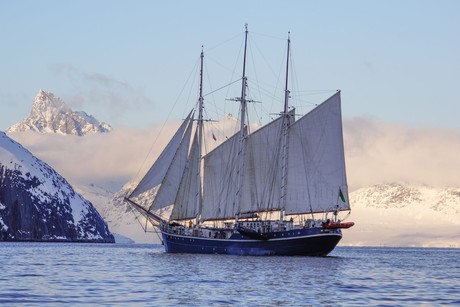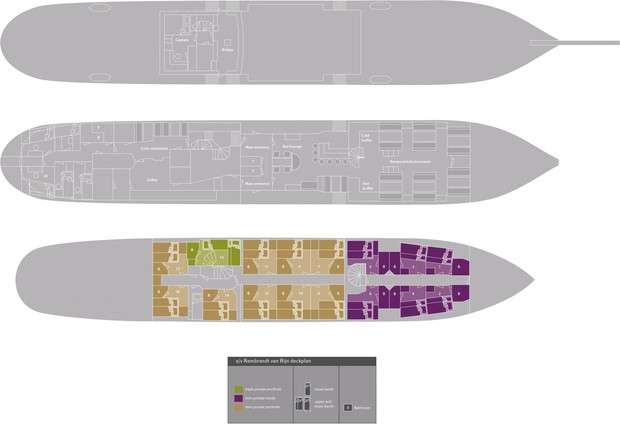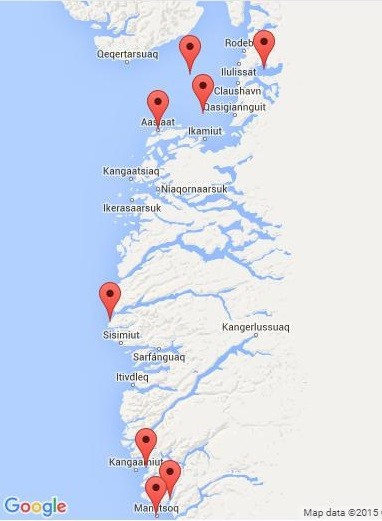Greenland or "Kalaallit Nunaat" ("Land of the People") in the Greenlandic language, is the largest island in the world, it stretches from 60º to 83º north latitude. Kap Farvel, its southern tip, is located at almost the same latitude as the Shetland Islands in Scotland. The extreme north of Greenland is the northernmost point of land on our planet. Greenland is dominated by the second largest ice-sheet in the world; more than 80% of its surface area is covered by ice reaching a thickness of over 3000 meters (10,000 feet) in the interior. Although huge in size (2,166,000 km²), it is inhabited by less than 60.000 people. Greenland is geographically a part of the North American continent but has more social and political ties with Europe.
The coastline of Greenland is spectacular. Heavily indented with numerous fjords, the coastline consists of spectacular high mountains, 2000 meters (6500 feet) high cliffs and innumerable glaciers. The large glaciers produce the huge, cathedral-like ice-bergs that are abundant in Greenlandic waters.
The name Greenland was given by Eric the Red, a Norwegian-born Icelandic settler who was banished from Iceland around the year 982 after committing a murder. He found refuge in Greenland. When his exile was over, he returned to Iceland with stories of a green and fertile land to the north-west to lure potential settlers, hence the name Greenland. Although initially flourishing, the Icelandic settlements disappeared from Greenland around 1400, probably due to a climatic change, the Little Ice-Age. But the Norwegian settlers were certainly not the first humans to have lived on Greenland. For thousands of years Palaeo-Eskimos (the Dorset culture) had been living on the coasts of Greenland: they were finally replaced by Inuit (or Kalaallit as they call themselves in Greenland) around 1300 A.D. The Inuit now make up the majority of the Greenlandic population. The Inuit, the word means "men" in the Inuit language, are nowadays seen as the indigenous people of the North American Arctic. Inuit are traditionally subsistence hunters, living primarily from whales, walruses, Caribou, Musk Oxen, Arctic Foxes, Polar Bears and seals.
Please note; Pack-ice is unpredictable and may prevent our ships to complete the planned itinerary.
Availability is always subject to confirmation. Please check with us before booking flights
There are no future departures for this trip at this stage.
Rembrandt van Rijn

| Length | 56 metres |
|---|---|
| speed | 9 knots |
| Cabins | 16 |
S/V ‘Rembrandt Van Rijn’ was originally built as a herring lugger. The vessel was rebuilt as a three-masted passenger sailing schooner in The Netherlands in 1994 and sailed in Spitsbergen (1994 – 1996) and in Galápagos (1998 - 2001). The vessel underwent a complete rebuilding and refurbishment program in 2011. The communication and navigation equipment has been completely renewed according to the latest SOLAS regulations.
The Rembrandt van Rijn measures 56 meters in length (168 ft.), 7 meters in width and has a draft of 2, 5 meters.
•The maximum engine speed is 9 knots
•She has an experienced crew of 12 on board including two tour guides
•The ship can accommodate a maximum of 33 passengers in 16 cabins
•1 Triple Private cabin with porthole (with shower and toilet)
•6 Twin Private Inside cabins (with shower and toilet, no porthole)
•9 Twin Private cabins (with shower and toilet and porthole)
•The general interior public areas include a spacious restaurant area so that all meals can be taken together as well as separate bar area and reading table area
•There is room to relax, read and socialize
•The ship is well suited for expedition cruising among small islands and offers excellent open deck viewing areas, even when under sail. The two inflatable rubber crafts (zodiacs) enable landing and wildlife viewing opportunities in otherwise inaccessible areas.
Deck plans are for illustrative purposes only – The actual ship and cabin layout may differ.

Includes
- Voyage aboard the indicated vessel as indicated in the itinerary.
- All meals throughout the voyage aboard the ship including snacks, coffee and tea.
- All shore excursions and activities throughout the voyage by Zodiac.
- Program of lectures by noted naturalists and leadership by experienced expedition staff.
- Free use of rubber boots and snowshoes on Plancius, Ortelius, Hondius and Janssonius.
- Free use snowshoes on Rembrandt van Rijn.
- On Spitsbergen voyages: Transfers and baggage handling between the airport, hotels and ship only for those passengers on the group flights to and from Longyearbyen.
- On Rembrandt voyages: Transfers and baggage handling between airport and ship at Constable Pynt on the chartered group flights.
- Luggage transfer from pick-up point to the vessel on the day of embarkation, in Ushuaia.
- Pre-scheduled group transfer from the vessel to the airport in Ushuaia (directly after disembarkation).
- All miscellaneous service taxes and port charges throughout the program.
- AECO fees and governmental taxes.
- Comprehensive pre-departure material.


